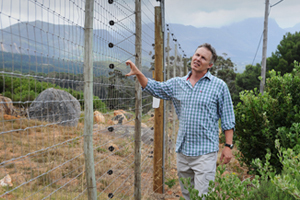Game fences to protect human and animal rights
17 March 2014
Electric game fences have been proposed as a solution to the conflict between humans and wild animals such as chacma baboons on the Cape Peninsula.
The proposal is for R20-million worth of game fencing to be erected around discrete urban areas (such as Scarborough and Misty Cliffs) where baboons currently range and raid.
The idea stems from Dr Bentley Kaplan's recently completed PhD thesis in which he tested a variety of cost-effective management options to reduce conflict.
The fence is noiseless (it doesn't hum or tick like some electric fences), and wild animals can approach the urban edges without being harassed by domestic dogs or people.
Professor Justin O'Riain of the Department of Biological Sciences' Baboon Research Unit argues that the once-off cost of the fencing should be weighed against the year-on-year cost of R10-million for field rangers with paintball markers who prevent baboon encroachment in residential areas.
The fences will also allow baboons to roam freely within Table Mountain National Park without the constant presence of and herding by field rangers, and may even allow for the reintroduction of other wildlife.
Living in a national park
"Living on the Cape Peninsula, we have to accept that this is a national park within a city and thus the edges are already very hard," notes O'Riain. "In other national parks, game fences reduce overlap between humans and their wild neighbours, and so help keep the peace." The Zwaanswyk-Tokai neighbourhood has been affected by baboon raiding for over a decade, leading to a drop in property prices and difficulties in selling prime properties.
However, since the installation of a baboon-proof game fence between the residential area and the reserve, the quality of life for both residents and baboons has improved, and they are now good neighbours, says O'Riain.
Kaplan's data show a 100% success rate since the Zwaanswyk fence was first erected in 2012, 18 months ago.
Previous PhDs in the research unit indicate that the primary driver of conflict between humans and baboons on the Peninsula was the systematic displacement of baboons to higher, more marginal land on Table Mountain National Park.
"We then proceeded to attract them with all manner of foreign bounty, including waste bins, grapes and exotic-fruiting gardens within the urban edge – and in so doing, set the stage for chronic conflict," adds O'Riain.
"We accept that humans and baboons do not make good co-habitors, and so need to be kept apart. This has shaped our thinking about the importance of densification on the Peninsula, to slow the sprawl that has choked off dispersal corridors and reduced baboon access to suitable low-lying foraging areas."
Human diseases in baboons
A consequence of high levels of overlap between humans and baboons has been the sharing not only of food, but of pathogens too. Baboons have tested positive for three human viruses (hepatitis A, Epstein-Barr and cytomegalovirus), and we share the same whipworm in our guts, says O'Riain.
The risk of contagion limits options for moving baboons off the Peninsula, and also serves as a red light to stop further co-habiting, as there are clear risks to both baboons and humans.
Long-term research by UCT graduate Esme Beamish, who did her MSc on the population dynamics of the Peninsula baboons, reveals that despite the challenges they face, this population is increasing and now numbers over 500 (up from 379 in 2006).
Even more gratifying is that the sex ratio has normalised: two to three females for every male.
"Not so long ago there were eight females to every male, because the males were raiding inhabited areas and being killed by irate residents," notes O'Riain.
Myth busters
A behavioural ecologist who applies his skills to conservation challenges, O'Riain says he has fought some frustrating battles with animal rights activists, who don't want to accept the findings of his group, or evidence that the conservation status of the Peninsula baboons has improved dramatically over the past decade.
"It is essential for researchers to communicate their findings to the public in a digestible format, and this has largely taken the form of public meetings after hours. It's here that my postgrads have been brilliant, systematically busting popular urban legends about baboons and the many falsehoods that are actively peddled.
"We can't educate the public enough about the reality of the Peninsula baboons' status. There are many false stories out there." An essential part of the research unit's work is also to forge links with local, provincial and government bodies and to assist with the shaping of management plans, protocols and policy.
"Social responsiveness is an important component of academic life and an essential part of making science 'relevant' in a developing country with established social challenges.
"The data will show the way forward."
Spreading expertise
But the Peninsula is not the only area with a baboon problem.
O'Riain's unit – supported by one postdoctoral, one doctoral, and two master's students – has been approached by Forestry South Africa to conduct a study that will help authorities understand how and why baboons damage trees in Mpumalanga's commercial plantations.
"It aims to first understand the behavioural and spatial ecology of baboons in a human-altered agricultural habitat, and then to use these data to devise sustainable solutions for this important agricultural sector," says O'Riain.
Story by Helen Swingler. Picture by Michael Hammond.
 This work is licensed under a Creative Commons Attribution-NoDerivatives 4.0 International License.
This work is licensed under a Creative Commons Attribution-NoDerivatives 4.0 International License.
Please view the republishing articles page for more information.










